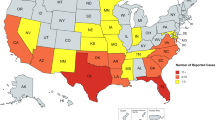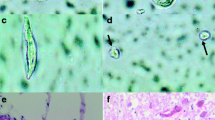Abstract
The genus Naegleria consists of free-living amoebae widely distributed worldwide in soil and freshwater habitats. Primary amoebic meningoencephalitis (PAM) is an uncommon and most likely fatal disease. The incubation period is approximately 7 days. The first symptoms are headache, nasal congestion, fever, vomiting, stiff neck within 3–4 days after the first symptoms, confusion, abnormal behavior, seizures, loss of balance and body control, coma, and death. We describe the case of a child who presented with PAM due to Naegleria sp., fully recovered from the infection without apparent sequels after treatment with a regimen that included miltefosine and voriconazole.

Similar content being viewed by others
References
Maciver SK, Piñero JE, Lorenzo-Morales J (2020) Is Naegleria fowleri an Emerging Parasite? Trends Parasitol 36(1):19–28. https://doi.org/10.1016/j.pt.2019.10.008
Grace E, Asbill S, Virga K (2015) Naegleria fowleri: pathogenesis, diagnosis, and treatment options. Antimicrob Agents Chemother 59:6677–6678. https://doi.org/10.1128/AAC.01293-15
Schuster FL, Guglielmo BJ, Visvesvara GS (2006) In-vitro activity of miltefosine and voriconazole on clinical isolates of free-living amebas: Balamuthia mandrillaris, Acanthamoeba spp., and Naegleria fowleri. J Eukaryot Microbiol 53:121–126. https://doi.org/10.1111/j.1550-7408.2005.00082.x
Jahangeer M, Mahmood Z, Munir N, Waraich U, Tahir IM, Akram M et al (2020) Naegleria fowleri: sources of infection, pathophysiology, diagnosis, and management: a review. Clin Exp Pharmacol Physiol 47:199–212. https://doi.org/10.1111/1440-1681.13192
Capewell LG, Harris AM, Yoder JS, Cope JR, Eddy BA, Roy SL et al (2015) Diagnosis, clinical course, and treatment of primary amoebic meningoencephalitis in the United States, 1937–2013. J Pediatric Infect Dis Soc 4:e68-75. https://doi.org/10.1093/jpids/piu103
De Jonchheere JF (2004) Molecular definition and the ubiquity of species in the genus Naegleria. Protist 155:89–103. https://doi.org/10.1078/1434461000167
Cope JR, Ali IK (2016) Primary amebic meningoencephalitis: what have we learned in the last 5 years? Curr Infect Dis Rep 18:31. https://doi.org/10.1007/s11908-016-0539-4
Siddiqui R, Mungroo MR, Anuar TS, Alharbi AM, Alfahemi H, Elmoselhi AB et al (2022) Antiamoebic properties of laboratory and clinically used drugs against Naegleria fowleri and Balamuthia mandrillaris. Antibiotics (Basel) 11(6):749. https://doi.org/10.3390/antibiotics11060749
Dunn AL, Reed T, Stewart C, Levy RA (2016) Naegleria fowleri that induces primary amoebic meningoencephalitis: rapid diagnosis and rare case of survival in a 12-Year-Old Caucasian girl. Lab Med 47:149–154. https://doi.org/10.1093/labmed/lmw008
Heggie TW, Kupper T (2016) Surviving Naegleria fowleri infections: a successful case report and novel therapeutic approach. Travel Med Infect Dis 16:49–51. https://doi.org/10.1016/j.tmaid.2016.12.005
Kim JH, Jung SY, Lee YJ, Song KJ, Kwon D, Kim K et al (2008) Effect of therapeutic chemical agents in vitro and on experimental meningoencephalitis due to Naegleria fowleri. Antimicrob Agents Chemother 52:4010–4016. https://doi.org/10.1128/AAC.00197-08
Linam WM, Ahmed M, Cope JR, Chu C, Visvesvara GS, da Silva AJ et al (2015) Successful treatment of an adolescent with Naegleria fowleri primary amebic meningoencephalitis. Pediatrics 135:e744–e748. https://doi.org/10.1542/peds.2014-2292
Martínez DY, Seas C, Bravo F, Legua P, Ramos C, Cabello AM, Gotuzzo E (2010) Successful treatment of Balamuthia mandrillaris amoebic infection with extensive neurological and cutaneous involvement. Clin Infect Dis 51:e7-11. https://doi.org/10.1086/653609
Aichelburg AC, Walochnik J, Assadian O, Prosch H, Steuer A, Perneczky G et al (2008) Successful treatment of disseminated Acanthamoeba sp. infection with miltefosine. Emerg Infect Dis 14:1743–1746. https://doi.org/10.3201/eid1411.070854
Roy SL, Atkins JT, Gennuso R, Kofos D, Sriram RR, Dorlo TP et al (2015) Assessment of blood-brain barrier penetration of miltefosine used to treat a fatal case of granulomatous amebic encephalitis possibly caused by an unusual Balamuthia mandrillaris strain. Parasitol Res 114:4431–4439. https://doi.org/10.1007/s00436-015-4684-8
Greer ND (2003) Voriconazole: the newest triazole antifungal agent. Proc (Bayl Univ Med Cent) 16:241–248. https://doi.org/10.1080/08998280.2003.11927910
Acknowledgements
The authors are grateful to Jorge Lopez-Sandoval, MD, and the Critical Care Unit of the Hospital de Emergencias Pediátricas for facilitating the rapid release of voriconazole and the staff of Tecnofarma Uruguay for the donation of miltefosine for the treatment of this patient. I AMCV would like to thank Paula Belén, my daughter, and S.I R.A. for their patience.
Author information
Authors and Affiliations
Corresponding author
Additional information
Publisher's Note
Springer Nature remains neutral with regard to jurisdictional claims in published maps and institutional affiliations.
Rights and permissions
About this article
Cite this article
Martínez, D.Y., Bravo-Cossio, F., Valdivia-Tapia, M.d. et al. Successful Treatment of Primary Amoebic Meningoencephalitis Using a Novel Therapeutic Regimen Including Miltefosine and Voriconazole. Acta Parasit. 67, 1421–1424 (2022). https://doi.org/10.1007/s11686-022-00591-9
Received:
Accepted:
Published:
Issue Date:
DOI: https://doi.org/10.1007/s11686-022-00591-9




